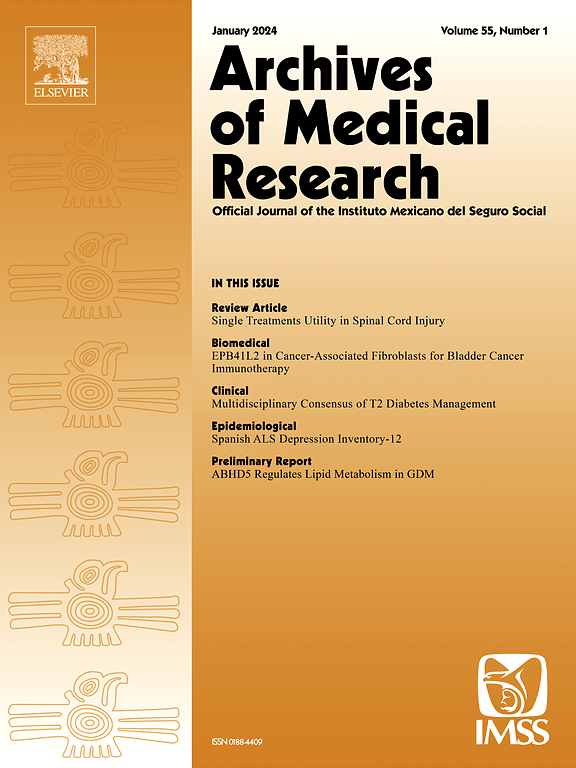Spironolactone Partially Reverses Autism-Like Behaviors Linked to ErbB4 and mTOR Phosphorylation in the Mouse Prefrontal Cortex and Striatum
IF 3.4
3区 医学
Q1 MEDICINE, RESEARCH & EXPERIMENTAL
引用次数: 0
Abstract
Background and Aims
Autism spectrum disorder (ASD) is a condition resulting from a combination of genetic and environmental influences that lead to atypical brain development, particularly in regions such as the striatum and prefrontal cortex. There is increasing evidence linking the epidermal growth factor (EGF) and its receptor (EGFR or ErbB1) to the etiopathogenesis of ASD. However, ErbB4, another ErbB member, has also been implicated in this process. To investigate whether dysregulation of ErbB4 and its downstream mTOR signaling pathway in the striatum and prefrontal cortex contributes to stereotypical behaviors and social deficits in an autism-like rodent model.
Methods
We analyzed the phosphorylation levels of ErbB4and mTOR in the prefrontal cortex and striatum of 31 d old mice that were prenatally exposed to valproate (VPA; 500 mg/kg) or the control vehicle (0.9 % NaCl). Social and stereotypic behaviors were assessed using the three-chamber social test and the marble burying test, respectively. Then, the VPA groups were treated with 50 mg/kg of spironolactone, a selective ErbB4 antagonist.
Results
Prenatal exposure to VPA induced deficits in social interaction and an increase in repetitive behaviors. These behaviors coexist with dysregulation of the ErbB4 phosphorylation and modifications in the mTOR signaling pathway in both brain regions. Treatment with spironolactone reduced repetitive behaviors, which was consistent with reduced ErbB4 phosphorylation and mTOR signaling.
Conclusions
These results support the idea that ErbB4 has abnormal expression and activity levels in the striatum and prefrontal cortex. Antagonizing ErbB4 with spironolactone improves repetitive behavioral patterns associated with ASD.

螺内酯部分逆转小鼠前额皮质和纹状体中与ErbB4和mTOR磷酸化相关的自闭症样行为
背景和自闭症谱系障碍(ASD)是一种由遗传和环境影响共同导致非典型大脑发育的疾病,特别是在纹状体和前额皮质等区域。越来越多的证据表明,表皮生长因子(EGF)及其受体(EGFR或ErbB1)与ASD的发病有关。然而,ErbB4,另一个ErbB成员,也参与了这一过程。研究纹状体和前额叶皮层ErbB4及其下游mTOR信号通路的失调是否与自闭症样啮齿动物模型的刻板行为和社交缺陷有关。方法分析了产前暴露于丙戊酸(VPA)的31日龄小鼠前额皮质和纹状体erbb4和mTOR磷酸化水平。500 mg/kg)或对照(0.9% NaCl)。社会行为和刻板印象行为分别采用三室社会测验和弹珠掩埋测验进行评估。然后,VPA组给予50 mg/kg选择性ErbB4拮抗剂螺内酯。结果胎儿期暴露于VPA可导致社会交往缺陷和重复行为增加。这些行为与ErbB4磷酸化的失调和两个脑区mTOR信号通路的修饰共存。螺内酯治疗减少了重复行为,这与ErbB4磷酸化和mTOR信号传导的减少是一致的。结论ErbB4在纹状体和前额叶皮层中表达和活性异常。用螺内酯拮抗ErbB4可改善与ASD相关的重复性行为模式。
本文章由计算机程序翻译,如有差异,请以英文原文为准。
求助全文
约1分钟内获得全文
求助全文
来源期刊

Archives of Medical Research
医学-医学:研究与实验
CiteScore
12.50
自引率
0.00%
发文量
84
审稿时长
28 days
期刊介绍:
Archives of Medical Research serves as a platform for publishing original peer-reviewed medical research, aiming to bridge gaps created by medical specialization. The journal covers three main categories - biomedical, clinical, and epidemiological contributions, along with review articles and preliminary communications. With an international scope, it presents the study of diseases from diverse perspectives, offering the medical community original investigations ranging from molecular biology to clinical epidemiology in a single publication.
 求助内容:
求助内容: 应助结果提醒方式:
应助结果提醒方式:


